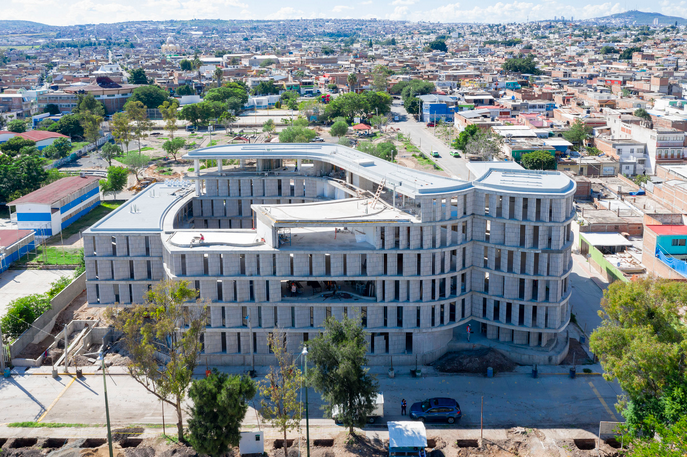The Fabricated Landscape exhibition at Carnegie Museum of Art

SO-IL, Las Americas Social Housing, Leon, Mexico, 2016.
@ Courtesy of SO-IL

SO—IL, TheGreenEyl, Connective Field, 2017, Carnegie Museum of Art, Drue Heinz Trust.
@ Courtesy of the Carnegie Museum of Art
Sat, Jun 26 - Mon, Jan 17 2022
From June 26, 2021 until January 17, 2022, the Carnegie Museum of Art presents The Fabricated Landscape, a group exhibition that features work by Dutch architects Anne Holtrop and SO-IL, alongside Assemble, Frida Escobedo, Go Hasegawa, LCLA Office, MAIO, OFFICE Kersten Geers David Van Severen, and UMWELT. Many of the practices will be presenting new work for the first time in the United States. The exhibition is on view in the Heinz Architectural Center, one of the foremost institutes for the study of architecture in the United States.
The Fabricated Landscape spotlights the designs of some of the most innovative figures working in contemporary architecture around the world today. Presenting projects from ten international practices, the exhibition reveals how this generation of architects, all of whom were born from 1975 and onward, explore the fundamental role that architecture and design play in our lives. The exhibition celebrates the field’s growing diversity and ingenuity by presenting practices that are responsive and attentive to the communities, localities, and cultures in which they are situated.
Visitors are transported around the world with representations of cutting-edge spaces from Japan and Scandinavia to Zimbabwe and Latin America. From single houses to large-scale infrastructure and public spaces, each practice aims to create lasting, sustainable solutions through traditional techniques and digital technologies.
A publication in three parts is forthcoming in fall 2021, distributed by Carnegie Museum of Art and Inventory Press. The first issue, Domestic, features contributions from: Emilio Ambasz, Go Hasegawa, Luisa Lambri, MAIO, and Raymund Ryan. The Fabricated Landscape is organized by Raymund Ryan, Curator-at-Large, Heinz Architectural Center, and designed by IN-FO.CO in Los Angeles.
Excerpt from “The Fabricated Landscape 1: Domestic”
“The Fabricated Landscape presents an emerging culture of architecture in which the smallest and most intimate of projects is connected to a vision of far more extensive landscapes and infrastructures.Young architects typically start independent practice with small residential works, a house extension or two, or a holiday home away from the city. I am sometimes asked why I find this or that project, or this or that practice, interesting. While a small structure may, of course, be delightful in itself, the honest answer is a sense that an architect’s design has been conceived with a larger agenda in mind, that the small project might be the first of multiple iterations, or that it should be understood within a larger physical and social ambition.
Even the most humble and circumscribed of buildings can gain value by being consciously situated in the context of urban form, of the means of production, of social good and environmental awareness. Whereas some of this approbation may result from intuition on the part of the critic or curator, architects themselves frequently have some such broader horizon in mind.
Considering this interrelationship between the small and the large, remember the 15th-century exhortation of Leon Battista Alberti that “the city is like a great house, and the house in its turn a small city.” Now that architects’ attention has expanded to include landscape and the environment, new connections are being made between ideas of the house and the way we inhabit the natural world.”
—Raymund Ryan, Curator-at-Large, Heinz Architectural Center
About the Heinz Architectural Center
Established in 1990, Heinz Architectural Center enhances appreciation and understanding of architecture and the built environment through exhibitions, lectures, charettes, symposia, and other forms of public engagement. Its collection of nearly 6,000 objects includes drawings, models, photographs, artifacts, games, ephemera, and the world’s third-largest collection of plaster architectural casts. Ranging from the late 18th century to the present, the collection represents work in architecture, landscape design,engineering, and furniture and interior design by architects of international, national, and regional significance.
The programs of Heinz Architectural Center are made possible by the generosity of the Drue Heinz Trust.
General operating support for Carnegie Museum of Art is provided by The Heinz Endowments and Allegheny Regional Asset District. Carnegie Museum of Art receives state arts funding support through a grant from the Pennsylvania Council on the Arts, a state agency funded by the Commonwealth of Pennsylvania.